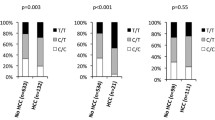Abstract
Hepatocellular carcinoma (HCC) is the leading cause of cancer mortality in many countries. Evaluation of new susceptibility risk factors is therefore warranted in order to explore means to improve the survival rate. Here, we report on a novel HCC-related gene known as lysosomal protein transmembrane 4 beta (LAPTM4B) that has two alleles designated LAPTM4B*1 and LAPTM4B*2. Allele *1 differs from allele *2 in that it contains one copy of a 19-bp sequence, whereas this sequence is duplicated in allele *2 in exon 1 of LAPTM4B. In this study, we aimed to investigate the relationship between LAPTM4B allelic variation and HCC susceptibility. The LAPTM4B genotype was analyzed in the blood samples from 102 HCC patients and 135 healthy individuals by PCR. The genotypic distribution of LAPTM4B was analyzed using the chi-squared test. The frequencies of allele *2 were 38.24 and 24.07% in the HCC group and control group, respectively, representing a significant difference between these two groups (P < 0.001). Thus, allele *2 of LAPTM4B appears to be associated with genetic susceptibility of HCC and may therefore be considered as a risk factor.


Similar content being viewed by others
References
Howe HL, Wingo PA, Thun MJ, et al. Annual report to the nation on the status of cancer (1973 through 1998), featuring cancers with recent increasing trends. J Natl Cancer Inst. 2001;93:824–42.
El-Serag HB, Rudolph KL. Hepatocellular carcinoma: epidemiology and molecular carcinogenesis. Gastroenterology. 2007;132:2557–76.
Llovet JM, Burroughs A, Bruix J. Hepatocellular carcinoma. Lancet. 2003;362:1907–17.
Landis SH, Murray T, Bolden S, Wingo PA. Cancer statistics, 1998. CA Cancer J Clin. 1998;48:6–29.
Edmondson HA, Steiner PE. Primary carcinoma of the liver: a study of 100 cases among 48,900 necropsies. Cancer. 1954;7:462–503.
Farazi PA, De Pinho RA. Hepatocellular carcinoma pathogenesis: from genes to environment. Nat Rev Cancer. 2006;6:674–87.
Suriawinata A, Xu R. An update on the molecular genetics of hepatocellular carcinoma. Semin Liver Dis. 2004;24:77–88.
Shao GZ, Zhou RL, Zhang QY. Molecular cloning and characterization of LAPTM4B, a novel gene upregulated in hepatocellular carcinoma. Oncogene. 2003;22:5060–9.
Meng F, Luo C, Hu Y, et al. Overexpression of LAPTM4B-35 in cervical carcinoma: a clinicopathologic study. Int J Gynecol Pathol. 2010;29:587–93.
Kasper G, Vogel A, Klaman I. The human LAPTM4b transcript is upregulated in various types of solid tumours and seems to play a dual functional role during tumour progression. Cancer Lett. 2005;224:93–103.
Zhou L, He XD, Chen J. Overexpression of LAPTM4B-35 closely correlated with clinicopathological features and post-resectional survival of gallbladder carcinoma. Eur J Cancer. 2007;43:809–15.
Yang Y, Yang H, McNutt MA. LAPTM4B over expression is an independent prognostic marker in ovarian carcinoma. Oncol Rep. 2008;20:1077–83.
Zhou L, He XD, Cui QC. Expression of LAPTM4B–35: a novel marker of progression, invasiveness and poor prognosis of extrahepatic cholangiocarcinoma. Cancer Lett. 2008;264:209–17.
Yang H, Xiong F, Qi R, et al. LAPTM4B-35 is a novel prognostic factor of hepatocellular carcinoma. J Surg Oncol. 2010;101:363–69.
Yang H, Xiong FX, Lin M, et al. LAPTM4B-35 overexpression is a risk factor for tumor recurrence and poor prognosis in hepatocellular carcinoma. J Cancer Res Clin Oncol. 2010;136:275–81.
Chen LR, Chao CH, Chen CF. Expression of 25 high egg production related transcripts that identified from hypothalamus and pituitary gland in red-feather Taiwan country chickens. Anim Reprod Sci. 2007;100:172–85.
Meng F, Song H, Luo C, et al. Correlation of LAPTM4B polymorphisms with cervical carcinoma. Cancer. 2011;117:2652–58.
Yin M, Li C, Li X, et al. Over-expression of LAPTM4B is associated with poor prognosis and chemotherapy resistance in stages III and IV epithelial ovarian cancer. J Surg Oncol. 2011;104:29–36.
Deng LJ, Zhang QY, Liu B, Zhou RL. Relationship between LAPTM4B gene polymorphism and susceptibility of lung cancer. Beijing Da Xue Xue Bao. 2005;37:302–5.
Li L, Wei XH, Pan YP, et al. LAPTM4B: a novel cancer-associated gene motivates multidrug resistance through efflux and activating PI3 K/AKT signaling. Oncogene. 2010;29:5785–95.
Meng F, Song H, Luo C, et al. Correlation of LAPTM4B polymorphisms with cervical carcinoma. Cancer. 2010;117: 2652–58.
Liu Y, Zhang QY, Qian N, Zhou RL. Relationship between LAPTM4B gene polymorphism and susceptibility of gastric cancer. Ann Oncol. 2007;18:311–6.
Cheng XJ, Xu W, Zhang QY, Zhou RL. Relationship between LAPTM4B gene polymorphism and susceptibility of colorectal and esophageal cancers. Ann Oncol. 2008;19:527–32.
Meng FL, Yin MZ, Song HT, et al. LAPTM4B-35 overexpression is an independent prognostic marker in endometrial carcinoma. Int J Gynecol Cancer. 2010;20:745–50.
Liu X, Xiong F, Wei X. LAPTM4B–35, a novel tetratransmembrane protein and its PPRP motif play critical roles in proliferation and metastatic potential of hepatocellular carcinoma cells. Cancer Sci. 2009;100:2335–40.
Bosch FX, Ribes J, Cleries R, Diaz M. Epidemiology of hepatocellular carcinoma. Clin Liver Dis. 2005;9:191–211.
Kaibori M, Ishizaki M, Saito T. Risk factors and outcome of early recurrence after resection of small hepatocellular carcinomas. Am J Surg. 2009;198:39–45.
Kamiyama T, Nakanishi K, Yokoo H. Recurrence patterns after hepatectomy of hepatocellular carcinoma: implication of milan criteria utilization. Ann Surg Oncol. 2009;16:1560–71.
Tanaka S, Mogushi K, Yasen M. Surgical contribution to recurrence-free survival in patients with macrovascular-invasion-negative hepatocellular carcinoma. J Am Coll Surg. 2009;208:368–74.
Conflict of interest
None.
Author information
Authors and Affiliations
Corresponding author
Additional information
Guojun Zhai and Hua Yang contributed equally to this work.
Rights and permissions
About this article
Cite this article
Zhai, G., Yang, H., Ji, X. et al. Correlation of LAPTM4B polymorphisms with hepatocellular carcinoma in Chinese patients. Med Oncol 29, 2744–2749 (2012). https://doi.org/10.1007/s12032-011-0139-y
Received:
Accepted:
Published:
Issue Date:
DOI: https://doi.org/10.1007/s12032-011-0139-y




